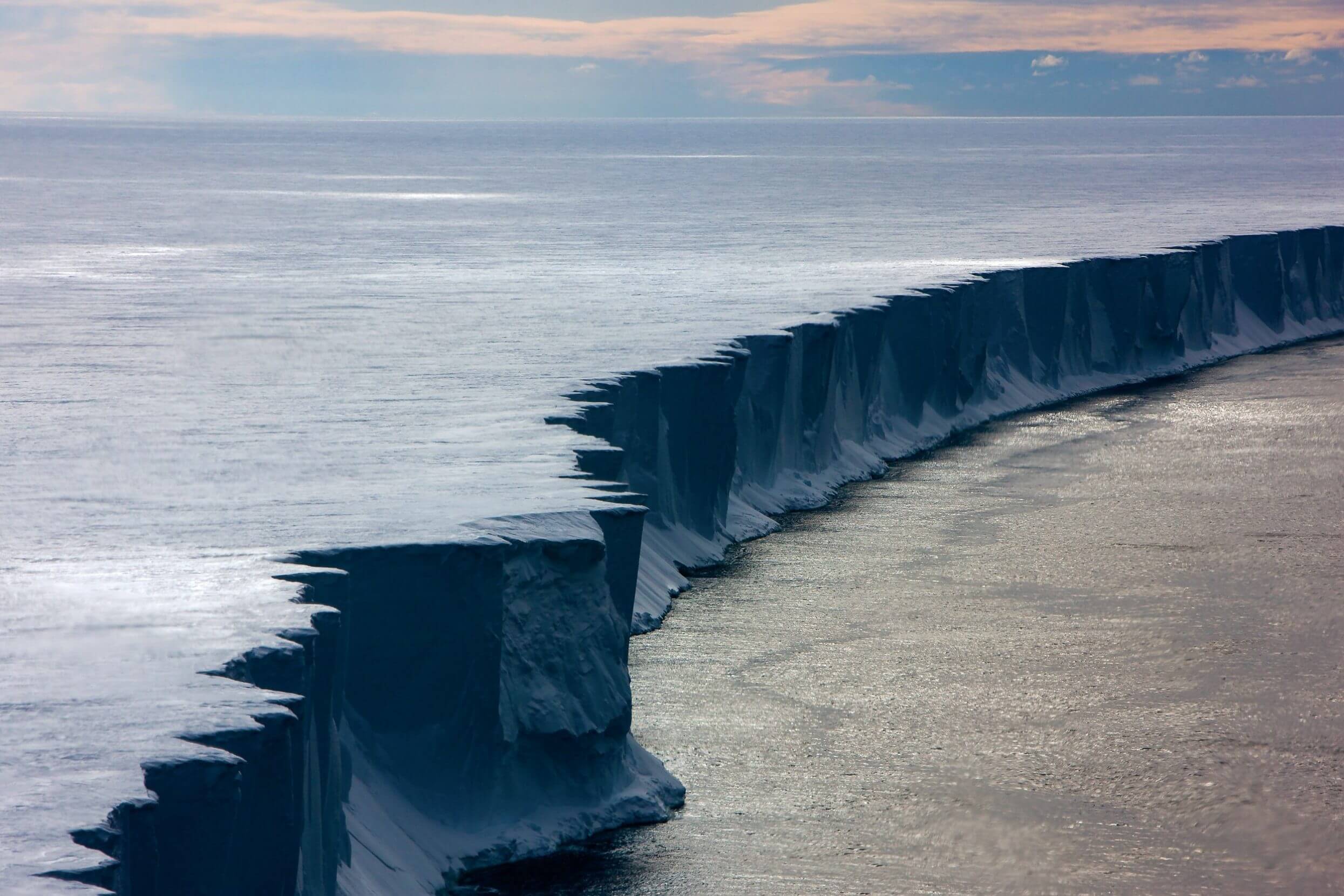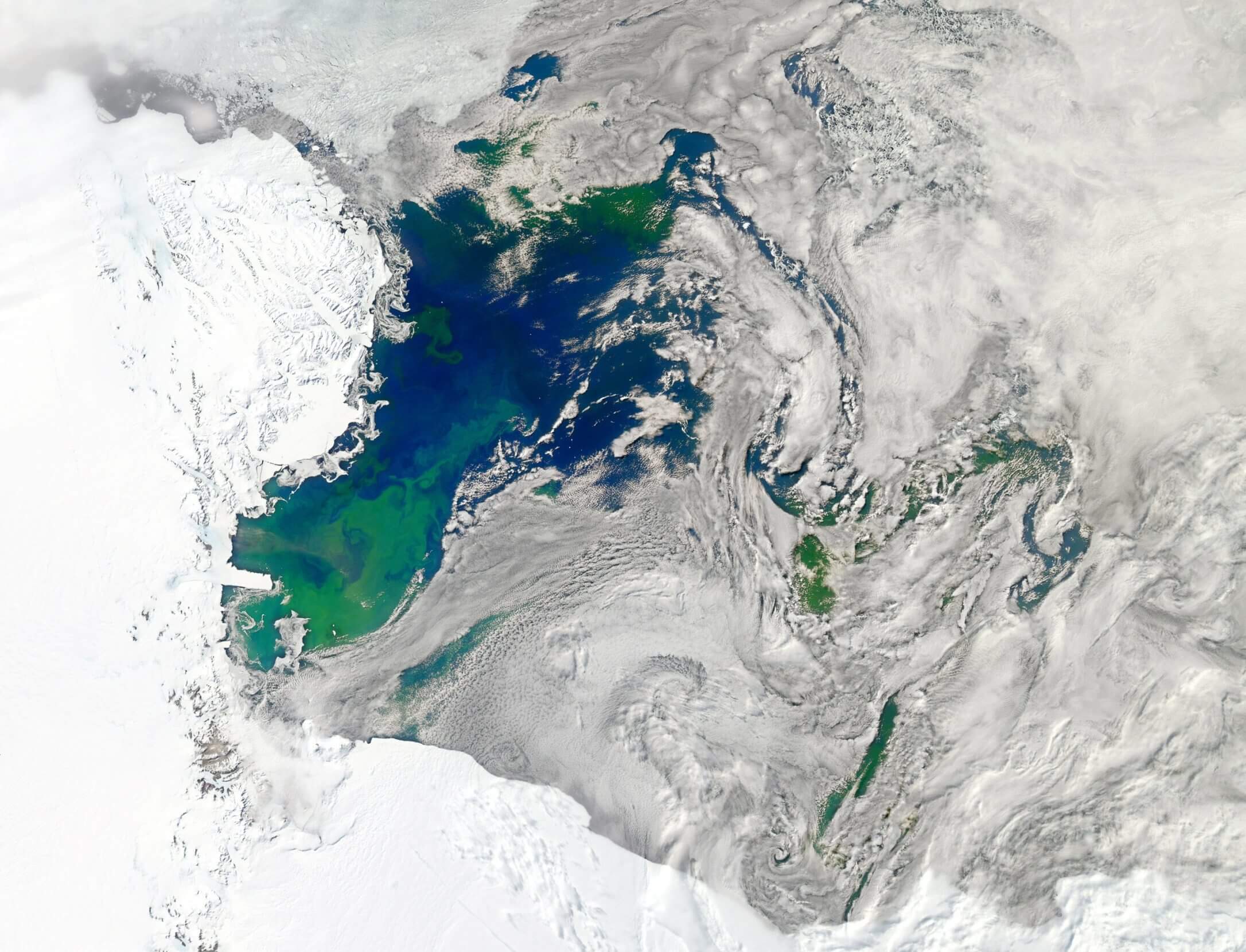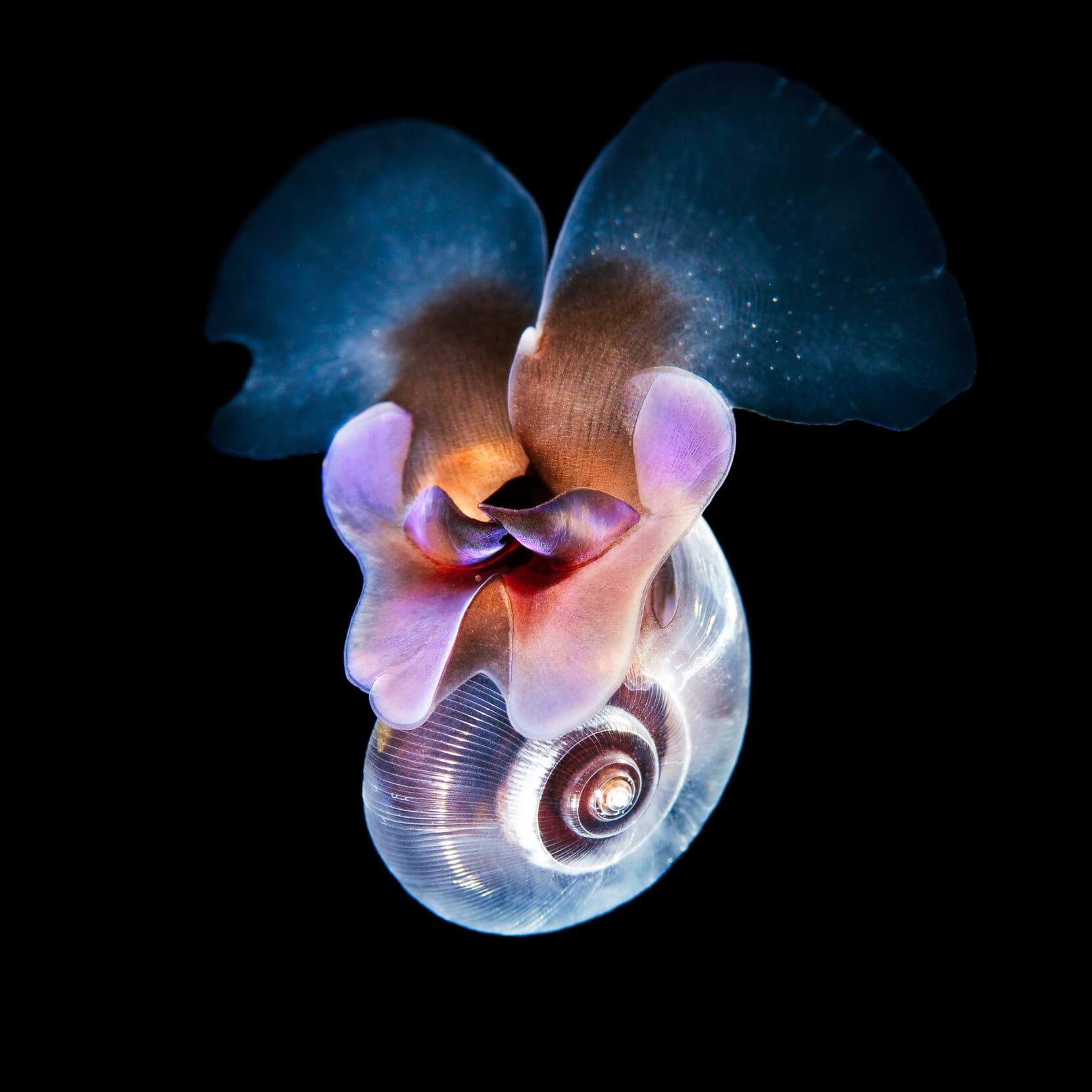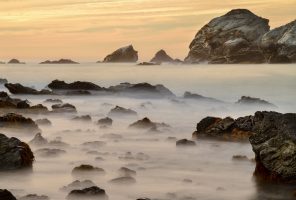Support Hidden Compass
We stand for journalism, science, history, and hope. Make a contribution to Hidden Compass and stand with us.
Clad in three layers of thermal underwear, insulated bib overalls, a parka, and waders, my range of motion is seriously impaired. I cautiously step into the Antarctic waters of McMurdo Sound — inching my bulbous “bunny boots” forward, carefully securing one foot before taking the next step.
I am undeniably out of my element. This Southern California science teacher lives a routine existence, my days dictated by a 5:30 a.m. alarm and the structure of a high-school bell schedule. That’s not to say I don’t navigate tough terrain in the classroom, ever pivoting between the biological wonders of our world and the stark facts of a changing planet. My students, who are inheriting both the awe and the urgency, hang in the balance.
I’ve always championed underdogs, whether teenagers or microorganisms.
As do “sea butterflies,” tiny, polar pteropods that are the marine equivalent to the canary in the coal mine: Their shells are dissolving in our increasingly acidic oceans. I have come to the Southern Ocean to study these water-bound warriors. But whether in the classroom or knee-deep in frigid waters, I worry a single, careless move could upend my progress.
As I dodge floating chunks of ice and fight to stay upright in the current, I hear someone on shore shout, “Be careful you don’t fall over! In this water hypothermia is a certainty.”
Fear hijacks my concentration, rendering me paralyzed. I become an audience of one, watching a single scene replay in my head: me toppling forward and plunging helplessly into a deep, dark, bitterly cold abyss.
~~
What lurks in these waters is what got me to Antarctica in the first place — planktonic Limacina helicina antarctica. What can I say? I’ve always championed underdogs, whether teenagers or microorganisms.
Easy to overlook, plankton play a herculean role in maintaining Earth’s biosphere. Phytoplankton — aka microscopic flora — are the lungs of the planet, providing at least half of our oxygen as they remove carbon dioxide from the atmosphere. As the seas absorb excess carbon dioxide, the pH level of the water drops.
Ocean acidification, as this process is known, is wreaking havoc on calcifying plankton. Rogue hydrogen ions deplete ocean waters of vital, shell-building carbonate ions. As the ion supply dwindles, plankton shells dissolve — “osteoporosis of the sea,” as it’s often called. Like the coral reefs of the world, L. helicina antarctica and its relatives are in trouble.
Without a means of protection, these largely defenseless drifters become easy prey. Given all the crucial resources they provide, it’s no exaggeration to say that if plankton disappear, the rest of us aren’t far behind.
On a two-month leave of absence from the classroom, I’m here to take my passion for all living things into the field and lab at Antarctica’s legendary McMurdo Station. Our research aims to determine the precise pH that precipitates shell deterioration in L. helicina antarctica here at high latitude, home to the highest profusion of pteropods.
Yet venturing to Earth’s end is just one step on my journey. My ultimate goal: to bring plankton to life for my students — and propel them into action, too. The struggle to find my footing comes with the territory.
~~
Five hours after boarding a C-17 military airplane in Christchurch, New Zealand, I land on the southern tip of Ross Island: no paved runway, no terminal, just ice. The dim confines of the cargo plane make way for the glaring brightness of a 24-hour sun reflected off endless ice.
Antarctica’s trademark wind stings my cheeks. A shuddering wave rolls through me. Putting on my UV-protective sunglasses, I tighten my wool scarf, zip my parka, and tentatively set foot on the 1,100-foot-thick Ross Ice Shelf.

The edge of Antarctica’s Ross Ice Shelf, the planet’s largest body of floating ice, looms more than 80 feet above the ocean. Photo: Andy Myatt / Alamy Stock Photo.
A cacophony beats against my eardrums: the thunder of the jet engine; squeals from excited, fellow researchers; the whir of our transport vehicle’s motor. A flood of emotion hits me. I’m standing amid the planet’s harshest environment and, well, it’s not just my pupils that feel blindsided.
As my eyes adjust, I catch my first glimpse of Mount Erebus, the world’s southernmost active volcano, a gaseous cloud rising from its crater. One thing is clear: This experience will push my limits. Is this what my students feel like, when they are thrust into a wild unknown?
~~
During long summer days, polar seas become awash in a swirling abundance known as the phytoplankton bloom. It paints the water hues of blue-green, brown, or red, but not for long: This floating buffet is soon devoured by L. helicina antarctica and other zooplankton. These minuscule animals, in turn, drift into the mouths of a multitude of other marine creatures, from shrimp-like krill to gigantic blue whales.

The Antarctic summer brings phytoplankton blooms to the Ross Sea, when an upswell of microscopic plants coats its cobalt waters. The phenomenon creates a marble effect when viewed from above, such as in this satellite image captured by NASA. Photo: NASA Earth Observatory.
Holding up the bottom of the food chain comes naturally for plankton. Facing an increasingly toxic environment does not. Since the Industrial Revolution, the oceans have become 30% more acidic — a change in chemistry not seen for at least 25 million years, and never so quickly. This shift will only intensify if humans continue pumping carbon dioxide into the atmosphere at current rates.
Without dramatic cuts in global carbon emissions, it’s only a matter of time before we sink past the ecological point of no return. The Southern Ocean could reach a milestone for ocean acidification — when the water contains a critically low amount of shell-building carbonate ions during seasonal fluxes — as soon as 10 years from now.
As L. helicina antarctica’s shell crumbles, so does the framework of our ecosystem. The very building blocks of life are at stake.
~~
Within 24 hours in Antarctica, I find myself at “snow school,” a hazing of sorts for new researchers here. Our challenge is to complete an overnighter on the ice — a survival necessity. Constructing a quinzhee, a hollowed-out snow dome, exhausts me, and I start fantasizing about my warm bed at home. Our instructor snaps me back to attention. Despite my fatigue, we still have to construct a windbreak of hardened snow bricks, haul our equipment to camp, and cook dinner.
Later, curled up in a fetal position on an inflatable air mattress, I am preoccupied with my freezing toes. The bottle of urine I had obediently filled and tucked at the foot of my sleeping bag is doing little to warm them.
Alone on the ice, sleep evades me, and my restless thoughts drift to my students in their comfortable homes in California. I picture their reaction to my present situation — both the giggles and the horror — and then my mind turns to their future. They, too, will need to step outside their comfort zone, to seek novel solutions to unexpected problems. Maybe my pee bottle will serve as a metaphor in a future class. I sleep, albeit fitfully, until dawn.
~~
Once a week, we helicopter to Cape Royds, the westernmost point of Ross Island, to collect plankton. Silenced by the pulsing whop, whop, whop of the rotor blades, I spend the flight gazing out the window. Azure sky, cobalt waters, and shockingly white ice create a landscape of remarkable beauty. It’s a blank canvas broken only by dark Weddell seals basking in the summer sun, near edges where the ice has thawed enough to crack.
In the water that infiltrates these crevasses, the occasional orca prowls for a seal dinner. Clouds ride on the wind, their shadows dancing across the ice. Though science beats at the heart of my mission, the art of this place takes my breath away.
As we land at our field site, I’m ecstatic to be out in the brisk air. Everything changes, though, once I pull on my waders and gingerly step into the current.
My apprehension peaks in the realm of the plankton. Supremely adapted to this world, they float effortlessly near the surface. I, on the other hand, am awkward and out of place, tasked with what feels like an impossibility: locating one-millimeter-wide zooplankton in dark blue water. I dip my plankton-collector, a plastic beaker tied to the end of a broom handle, into the water and hope for the best. Lifting the water into the light is the only way to tell if I’ve been successful.

Most abundant in polar seas, the planktonic Limacina helicina antarctica flaps its winglike parapodia to briefly “fly” underwater, earning it the nickname “sea butterfly.” Photo: Alexander Semenov.
On the rare occasion I capture a specimen, I transfer it to a lidded jar. Easier said than done, this process requires clasping the broom handle under one armpit and using gloved hands to lift the jar out of my waders, unscrew the lid, pour in the plankton, and secure the lid — all the while staying upright in a tossing current. When the jar is full, I shuffle to the beach, hand it off to a researcher on shore, and return to the water. Then, the process starts again.
Every once in a while, a bemused Adélie penguin emerges from the water and waddles through our makeshift camp, stopping momentarily to give us a quizzical glance. They, too, are plankton collectors feeding on krill. They show no wariness because their predators dwell offshore.
Still, penguins must plunge into waters replete with danger. All the protection and preparation in the world can only get them so far; survival is as much a matter of luck as it is a strategy.
~~
At the research lab, I marvel at the beauty and grace of L. helicina antarctica. In sharp focus under a microscope, delicate, wing-like parapodia extend from their spiral shell, which I inspect for signs of dissolution.
It’s no exaggeration to say that if plankton disappear, the rest of us aren’t far behind.
I hold a bottle full of these sea butterflies to the light. Like tiny ballerinas, they glide and swirl around the contours of the bottle, as if performing a loosely choreographed dance routine. Flapping their parapodia allows them to “fly” short distances through the water, but they are largely helpless creatures. They go where the current takes them — or whichever direction the bottle slants.
Holding so much life fills me with awe. I owe my very existence to these snails and their fellow plankton. Their plight takes on a newfound sense of urgency, as does my responsibility to convince my students to care about these small but mighty beings. Can I compel the next generation to stem the tide of ocean acidification?
~~
None of this, however, is on my mind as I lurch face-first toward the Southern Ocean. It’s my final day at the field site and I have grown smug. Carrying a bottle full of plankton and lumbering toward the shore, I hit a dip in the ocean floor and find myself in free fall.
Adrenaline rushes through my body as I frantically stab for sturdy footing. My mind jumps to visions of an airlift taking my hypothermic body to the McMurdo hospital.
And then, just as abruptly, I secure my feet and stay upright. My panic subsides, but my senses have roared awake.
Our insecurity is visceral.
~~
Already, in the Southern Ocean and along the western coast of the United States, plankton shells are dissolving, leaving them vulnerable to demise.
But reasons for hope remain: Recent research has shown evidence of resilience among calcifying plankton. Some pteropods have risen to the occasion, regenerating shells with thicker walls — in effect, fighting ocean acidification with stronger armor.
The destiny of L. helicina antarctica and its relatives is predicated in part on the information stored in their DNA and, more to the point, on human action.
My students share the same imperiled future. Yet their fate — along with the fate of the planet — is in their own hands. Will they yield to the undertow? Or will they seize the helm, and steer us to safety?
I can’t control their course through these waters any more than I can stop the damaging effects of ocean acidification. What I can do is stand steady on the shore, empowering tomorrow’s leaders to persevere — no matter how unstable the ground feels beneath their feet.
Laine Gonzales
Laine Gonzales is a biologist and high school science teacher. When school is not in session, she’s typically on the road.
Never miss a story
Subscribe for new issue alerts.
By submitting this form, you consent to receive updates from Hidden Compass regarding new issues and other ongoing promotions such as workshop opportunities. Please refer to our Privacy Policy for more information.



